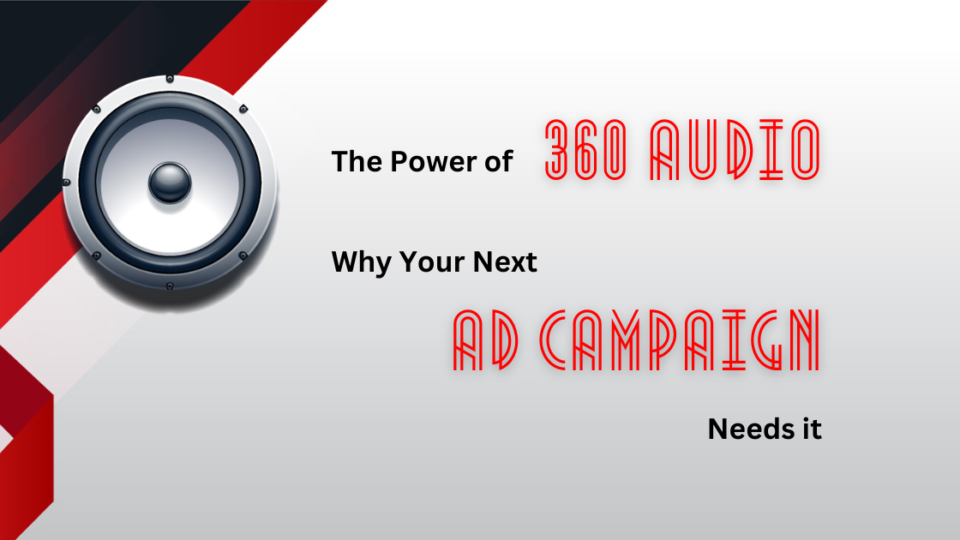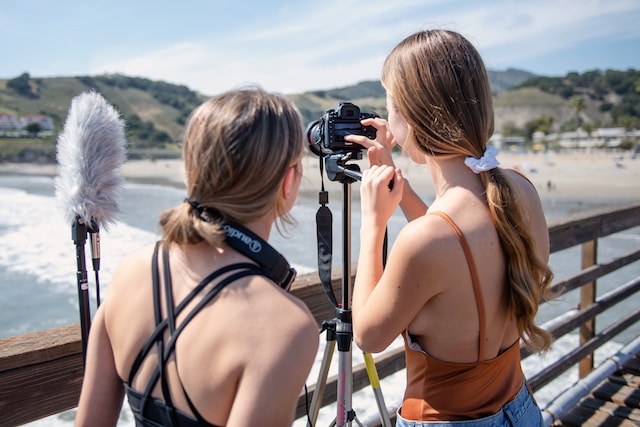Planning And Pre-Production
Planning and pre-production is the first stage in creating a 360 Audio Soundscape for your commercial.
It involves planning and preparing for the recording process to ensure that you capture the highest quality audio and create an immersive soundscape that effectively communicates your message to the audience.
Here are some of the key steps involved in planning and pre-production:
Identifying the goals and objectives of the commercial:
Determine what you want to achieve with the commercial and what message you want to convey. This will guide your decisions about the type of soundscape to create.
Understanding the target audience and their preferences:
Consider who your target audience is and what type of audio experience they would prefer. This will help you create a soundscape that engages and resonates with them.
Deciding on the type of 360 Audio Soundscape:
Choose the type of soundscape that best suits the commercial. There are different types of soundscape, including ambient soundscape, dynamic soundscape, and personalized soundscape.
Choosing the appropriate equipment for recording the sound:
Select the right microphones, recording devices, and other equipment for capturing high-quality audio.
Scouting locations:
Identify locations that are suitable for the soundscape you want to create. This may involve visiting and testing various locations to see which works best.
By taking the time to plan and prepare, you can ensure that you create a 360 Audio Soundscape that effectively communicates your message to the target audience.
This will make the commercial more engaging and memorable, and will enhance the overall experience for the audience.
Recording The Audio
Recording the audio is the second stage in creating a 360 Audio Soundscape for your commercial. This stage involves capturing high-quality audio that will be used to create an immersive soundscape.
Here are some of the key steps involved in recording the audio:
Selection of the location for recording:
Choose a location that is appropriate for the soundscape you want to create. For example, if you want to create an urban soundscape, record in a city or busy street.
Use of multiple microphones for capturing sounds from all directions:
To create a 360 Audio Soundscape, you need to capture sounds from all directions. Use multiple microphones, positioned in different locations, to capture sounds from different angles.
Ensuring quality sound recording:
It’s important to capture high-quality audio to create an immersive soundscape. Make sure your equipment is properly set up and that you’re using high-quality microphones.
Capturing natural and ambient sounds: In addition to capturing the sounds of the subject, you should also capture natural and ambient sounds to create a more realistic and immersive soundscape.
Adjusting the gain to avoid distortion:
Avoid distortion by adjusting the gain to the appropriate levels. Distorted audio can ruin an otherwise great soundscape.
By following these steps, you can capture high-quality audio that is suitable for creating an immersive 360 Audio Soundscape.
This will make the commercial more engaging and memorable, and will enhance the overall experience for the audience.
Editing The Audio
Editing the audio involves taking the audio recordings and manipulating them in various ways to create a cohesive and immersive soundscape for your commercial.
This process typically involves using audio editing software to manipulate the different audio tracks that were recorded.
One of the key steps in editing the audio is combining the different tracks that were recorded using multiple microphones. This involves synchronizing the audio tracks and blending them together to create a cohesive sound.
Another important step in editing the audio is adding sound effects and music. Sound effects can be used to enhance the soundscape and make it more immersive, while music can help set the tone and create an emotional connection with the audience. Choosing the right sound effects and music is essential to creating a successful 360 Audio Soundscape.
In addition to adding sound effects and music, editing the audio also involves balancing the levels of the different sounds to ensure that no sound is too loud or too quiet. This ensures that the listener has a smooth and enjoyable experience while listening to the soundscape.
Finally, mixing the audio tracks is the process of blending all of the sounds together to create a cohesive and immersive soundscape.
This involves adjusting the volume levels of each sound, panning sounds to create a sense of space, and applying effects to make the soundscape more interesting and engaging.
Overall, editing the audio is an essential step in creating a 360 Audio Soundscape for your commercial. It involves manipulating the audio tracks to create a cohesive and immersive experience that effectively communicates your message to the audience.
Testing The Audio
Testing the audio involves playing the 360 Audio Soundscape in a 360 environment and checking for any issues or inconsistencies in the audio.
This step is crucial to ensure that the audio is properly synced with the visuals of the commercial and that it provides an immersive experience for the listener.
One way to test the audio is to play it in a 360-degree audio environment, such as a virtual reality headset or a surround sound system.
This allows you to experience the audio as it would be heard by the listener and to check for any issues, such as gaps or inconsistencies in the audio.
Another important aspect of testing the audio is ensuring that it is compatible with different devices and speakers.
This involves testing the audio on a variety of speakers, such as headphones, computer speakers, and sound bars, to ensure that it sounds good on all devices.
During the testing phase, it’s also important to check that the audio is properly synced with the visuals of the commercial.
This involves watching the commercial while listening to the audio and ensuring that they are in perfect synchronization.
By testing the audio, you can identify any issues or inconsistencies and make any necessary adjustments to ensure that the 360 Audio Soundscape is immersive, engaging, and effective in communicating the message of the commercial to the audience.
Finalizing The Audio
Finalizing the audio involves making any necessary adjustments to the 360 Audio Soundscape and exporting it in the appropriate format for publishing. Here are some of the key steps involved in finalizing the audio:
Making any necessary adjustments to the audio:
After testing the audio, you may identify issues that need to be addressed. This may involve adjusting the levels of different sounds, re-recording certain sections, or making changes to the mix.
Exporting the final audio in the appropriate format:
Different platforms may require different audio formats, so it’s important to export the audio in the appropriate format for where it will be published. For example, YouTube requires audio to be in the AAC format, while Facebook supports MP3 and AAC.
Ensuring that the audio is compatible with the platform where it will be published:
Before publishing the audio, it’s important to check that it is compatible with the platform where it will be published. This may involve testing the audio on different devices and checking that it sounds good on all of them.
Saving and backing up the audio files: It’s important to save and backup the audio files in a safe location to prevent loss of data.
By finalizing the audio, you can ensure that the 360 Audio Soundscape is polished, professional, and ready for publishing.
This will enhance the overall experience for the audience and make the commercial more memorable and engaging.
Importance Of 360 Audio Soundscape In Commercial
360 Audio Soundscape is an immersive audio experience that creates a 3D audio environment around the listener.
In a commercial setting, 360 Audio Soundscape can significantly enhance the viewer’s experience by making it more engaging and memorable.
The importance of 360 Audio Soundscape in commercial lies in its ability to create a more interactive and dynamic experience for the viewer.
It allows the listener to feel like they are in the middle of the action, which can make the commercial more memorable and effective in conveying its message.
For example, a 360 Audio Soundscape in a car commercial can allow the listener to experience the sound of the car’s engine revving up, the wind rushing past the car, and the sound of the car’s tires on the road, all from different spatial locations.
This creates a more realistic and immersive experience for the listener, making them feel more connected to the car and the brand.
Moreover, 360 Audio Soundscape can help to differentiate a brand from its competitors by creating a unique and memorable audio experience that can leave a lasting impression on the viewer. This can lead to increased brand recognition and recall and ultimately, increased sales.
Overall, the importance of 360 Audio Soundscape in commercials lies in its ability to create a more engaging, immersive, and memorable experience for the viewer.
By using 360 Audio Soundscape in a commercial, brands can differentiate themselves from their competitors and create a more impactful message that resonates with their target audience.
Conclusion
Creating a 360 Audio Soundscape for your commercial can enhance the overall experience for the audience and make the commercial more engaging and memorable.
Planning and pre-production, recording the audio, editing the audio, testing the audio, and finalizing the audio are all important steps in the process.
By planning and preparing, using the appropriate equipment for recording, and editing and mixing the audio to create a cohesive and immersive soundscape, you can create a commercial that effectively communicates your message to the target audience.
Before publishing, remember to test the audio and ensure it is compatible with different platforms and devices.
By following these tips and tricks, you can create a unique and engaging 360 Audio Soundscape that enhances the overall commercial experience for the audience.









